Hunan, China
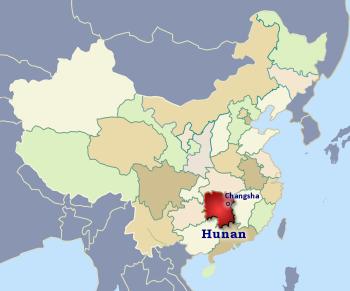
| Province | Hú nán 湖南 'lake south' |
| Short name | 湘 Xiāng |
| Capital | Changsha |
| Population | 66.445 million (4.70%) [7th] comparison table |
| Area | 212,000 km2 [81,853 mile2] (2.21%) [10th] |
| GDP | 62,881 (16.70%) [16th] |
| Neighbors | Hubei Jiangxi Guangdong Guangxi Guizhou Chongqing |
| Others | or just click on the map |
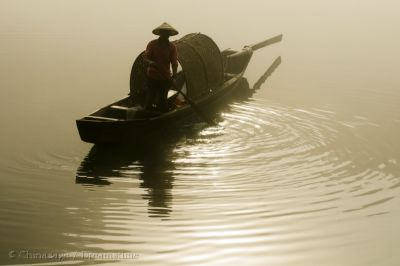
Hunan province covers the river basins of the Yuan and Xiang rivers that both drain north-eastwards into the vast Dongting Lake and from there into the Yangzi River (known in China as the Chang Jiang). The name originates from its position south of the Dongting Lake (the second largest freshwater lake in China) which is on the flood plain of the Yangzi. The shortened name for the province is the river name ‘Xiang 湘’.
Hunan stands in the rich heartland of south central China surrounded by mountains. It has produced food to feed the northern provinces for centuries. The rapid growth of population in the 19th century led to famine, fueling support for the Taiping Rebellion and in the 20th century the Republican movement.

Image by X. Zhou ➚ available under a Creative Commons license ➚
Changsha - provincial capital
Changsha (meaning ‘long sandbar’) is the largest city in Hunan and its history goes back 4,000 years, it stands on the busy overland route to Guangzhou, Guangdong. The Mawangdui ➚ museum in Changsha holds many archaeological finds from ancient times dating from the Spring and Autumn period onwards. The center piece is a marvelously preserved body of a noblewoman from 2,000 years ago. There is a legacy of foreign development which came when the city became a treaty port in 1903. It was one of the last cities to fall to Japanese occupation in 1944. Orange Island ➚ has a memorial to Mao Zedong complete with a carving of his poem called ‘Changsha’ celebrating his home province. The city has a number of other sites relating to Mao's life.
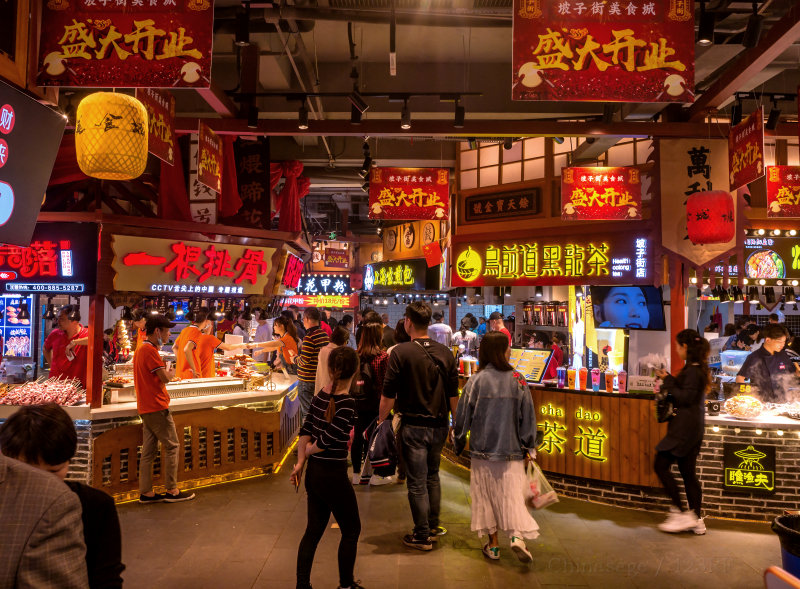

Alone I stand in the autumn cold
On the tip of Orange Island,
The Xiang flows northward;
I see a thousand hills crimsoned through
By their serried woods deep-colored,
And a hundred barges vying
Over crystal blue waters.
Eagles split the air,
Fish glide in the limpid deep;
Under freezing skies millions of creatures contend for freedom.
Brooding over this immensity,
I ask, on this boundless land
Who rules over man's destiny?
Part of Mao Zedong's poem “Changsha”.
Elsewhere in Hunan
Liuyang to the north east is famous for the manufacture of firecrackers - an indispensable part of any Chinese celebration. Up the Xiang river Hengyang is a large industrial city which also mines nearby mineral deposits. Mount Heng (or Hengshan the southernmost of two with that bear this name) is a famous Daoist sacred mountain with many temples dotted around the forested slopes. It is a popular tourist destination. The Nanyue Damiao (Great Southern peak Temple) has been rebuilt several times since its foundation in 726CE. The main hall has 72 pillars representing the 72 peaks of the Hengshan mountain range. Furongzhen is famous as the ‘Hibiscus Town’ of writer Gu Hua ➚.
Wulingyuan Scenic Area ➚ (also called Zhangjiajie) is in the north west of the province, it is a large 243 sq miles [629 sq kms] forested and mountainous area. UNESCO ➚ has designated the area as important for its wildlife and astonishing rock pinnacles. Within the area are Huangshi Zhai (peak area), Kongzhong Tianyuan (Heavenly garden) viewing point, Xianren Qiao (Immortals’ Bridge - a narrow stone bridge over a chasm) and Tianzi Ge another viewing point. The area was made famous worldwide because the Avatar film ➚ was made here.
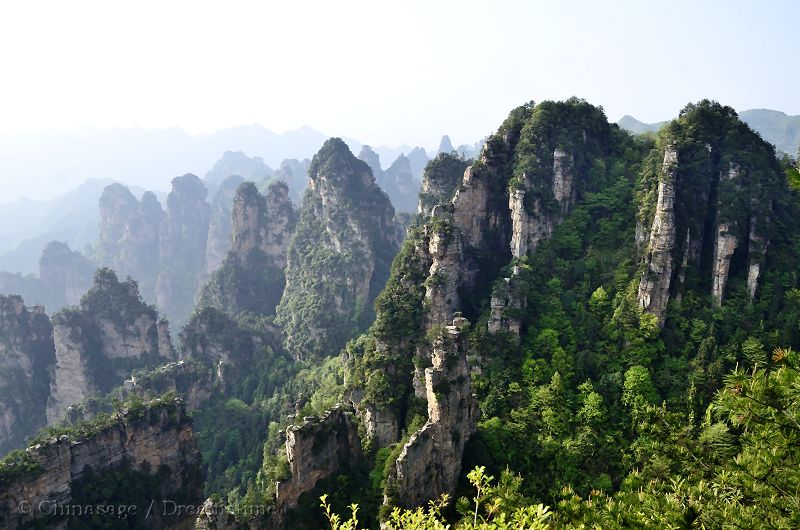
Yueyang Tower ➚ (岳阳楼 Yuè yáng lóu) is an ancient pavilion overlooking Dongting Lake at the northern tip of the province. It commemorates battles going back to the Warring States period but has been rebuilt several times most recently in 1867; the tower of three levels now forms the western gate of Yueyang City. To the side of the tower is a pavilion named Drunk Three Times ➚ commemorating the legendary life of Tang itinerant and Daoist immortal Lu Dongbin. Both Du Fu and Li Bai , famous poets of the Tang dynasty wrote poems about the tower at Yueyang. Poetry competitions were held here. Here is Du Fu's poem
“Long ago I heard of Dongting,
Today I climb the sunny tower.
The immense lake divides the lands of Wu and Chu,
The sun and moon float before me both day and night.”

Dongting Lake has for thousands of years acted as a buffer reservoir for the Yangzi when it is in full spate in the late summer to prevent flooding further downstream. The lake can grow to seven times its size. However with the Three Gorges Dam and increased water abstraction the lake has been diminishing in area.
There is a mausoleum to China's legendary Emperor Shennong at Yandi Park ➚, Zhuzhou. Hunan (or Xiang) cuisine is famous for its spicy dishes. Green Tea produced at Dayong and Yinfeng are highly regarded teas. Junshun Silver Needle ➚ tea, ‘The tea of Emperors’ is grown to the west of Dongting Lake on the island of Junshun. On this island grows a rare speckled form of bamboo, said by legend to be speckled from the tears of King Shun's widows.
Shaoshan is famous as the birthplace of Mao Zedong and has many exhibits chronicling his early life there. His family still live there - about 60% of the population bear the Mao family name.
Liling near the border with Jiangxi has kaolin deposits and with coal nearby was an ideal place to make porcelain. It has many kilns and produces pieces of distinctive design.
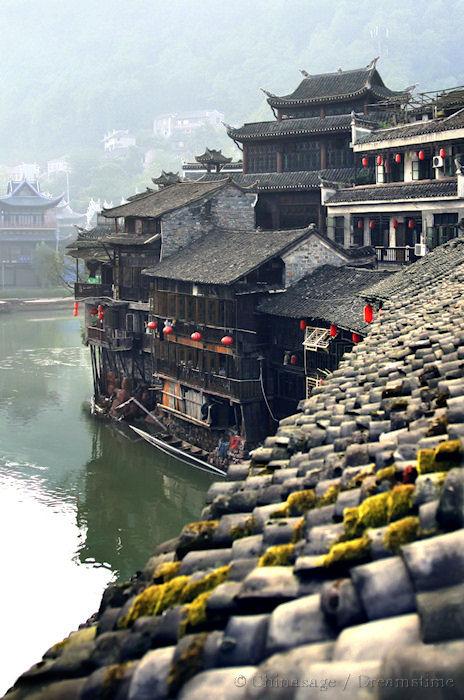
Hunan History
Archaeology gives evidence for an advanced culture as far back as the Shang dynasty. During the Five Dynasties it became, briefly the kingdom of Ma before being absorbed into the Tang empire. It then became a vital source of food (mainly rice) for the cities of the north, Qu Yuan met his death in the Miluo river north of Changsha, and the Dragon Boat Festival (Duanwu) marks this event throughout the world. The mountainous fringes of Hunan are home to a number of minority people: Miao, Tujia, Dong and Yao, but most of the rich lowland area has been settled by Han Chinese since the Warring States Period. At this time the province was part of the larger 湖广 Hú guǎng province before it was split from Hubei in 1664. During the Qing dynasty friction with Han settlers led to a series of Miao Rebellions ➚ which were brutally put down. The Hunan people are known for dogged resistance, they held out against the Taiping rebels with the help of Zeng Guofan's ‘Hunan Braves’. Liu Shaoqi, one time chairman of the Communist Party, was also born in the province at Ningxiang. Another Hunanese who fell into Mao's disfavor was Peng Dehuai ➚. Hu Yaobang was also born here. In 1928 the Communist Pingjiang Uprising ➚ took place in Hunan against the Guomindang.
It has in the past provided more rice than any other province. The rich agricultural land is in the east while the mountainous west remains sparsely populated by mainly ethnic peoples. Timber is a major crop of the western part. There are also large deposits of coal in the south.
By many statistical measures Hunan is an average province, so it typifies the whole of China which befits its central geographical position.
Airports
The airport has 2 terminals and is located 14.9 miles (24.0 kms) from Changsha. Live Flight information ➚, Airport information ➚, rank in China 14
International Links to :Korea
See map of location Changsha Huanghua International Airport
The airport has 1 terminal and is located 2.5 miles (4.0 kms) from Zhangjiajie. Live Flight information ➚, rank in China 58
See map of location Zhangjiajie Hehua International Airport
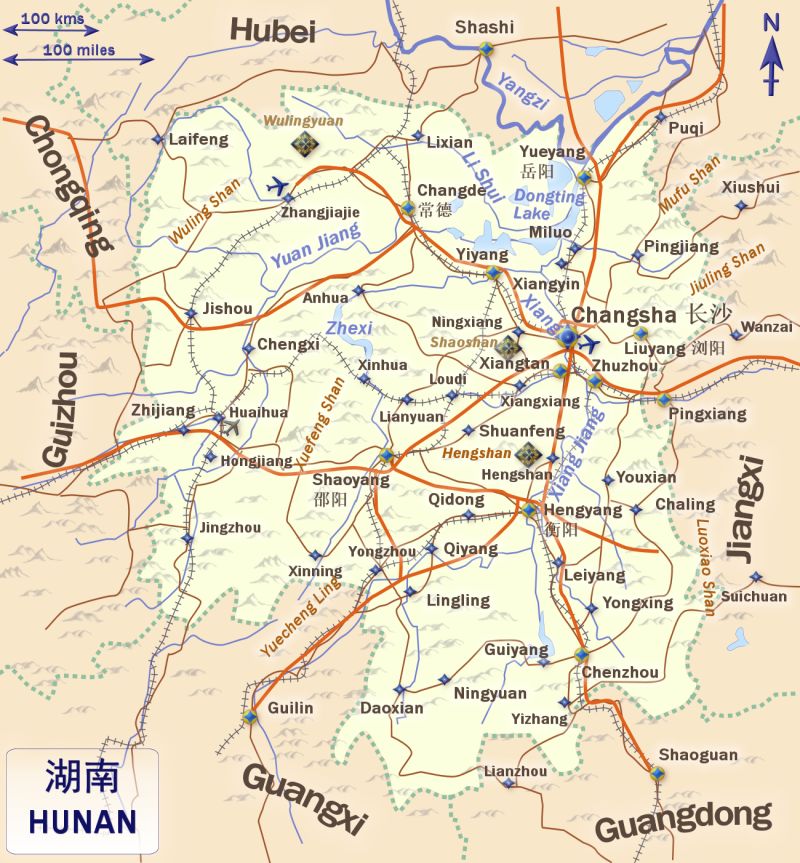
Google map of Hunan
Bing map of Hunan ➚
Show Bing Map ➚
Hunan Climate
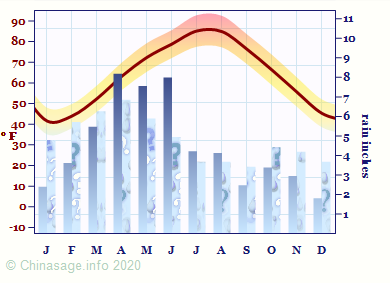
| Major Cities | Population | |
|---|---|---|
| Changde | 常德 | 1,457,519 |
| Changsha | 长沙 | 5,980,707 |
| Chenzhou | 郴州 | 960,000 |
| Fenghuang | 凤凰 | 370,000 |
| Hengyang | 衡阳 | 1,453,000 |
| Liuyang | 浏阳 | 1,278,928 |
| Shaoyang | 邵阳 | 339,575 |
| Xiangtan | 湘潭 | 674,189 |
| Yiyang | 益阳 | 202,608 |
| Yueyang | 岳阳 | 1,200,000 |
| Zhangjiajie | 张家界 | 225,700 |
| Zhuzhou | 株洲 | 709,358 |
Book: 60 Scenic Wonders in China: New World Press: 1980 pp. 133-136, 143-147
Book: A Map History of Modern China: Catchpole: Heinemann: 1976 pp. 4, 40
Book: China : Eyewitness Travel: Dorling Kindersley: 2012 pp. 259-265
Book: Lonely Planet: China: 1988 pp. 217-229
Book: Modern China: A companion to a rising power: Graham Hutchings:… pp. 218-220
Book: Nagel's Encyclopedia guide: China: Nagel: 1978 pp. 1133-1153
Book: The Water Kingdom: Philip Ball: Vintage: 2017 p. 39
Web page: Hunan (tandfonline) ➚
Web page: Hunan Map and Travel Guide ➚
Web page: Hunan Travel Guide - The Province Where President Mao Was From ➚
Web page: Hunan Travel Guide: Location: Map: Climate: Attractions: Highlights ➚
City populations for 2012, Province statistics National Bureau of Statistics 2014